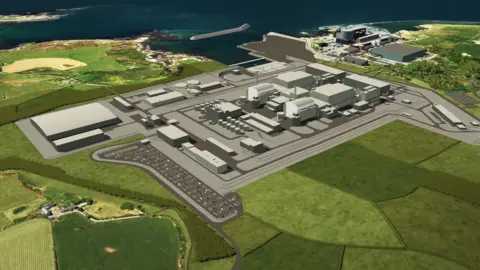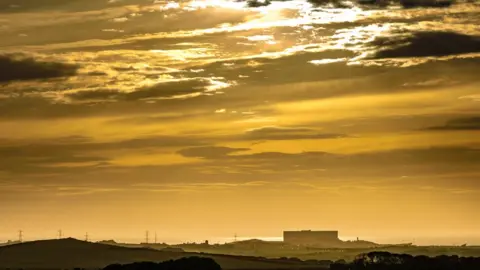Wylfa Newydd and the energy gap
 Horizon Nuclear
Horizon Nuclear"Arguably we have the best site in Europe here for new nuclear build."
That's how Horizon Nuclear Power described its base on Anglesey in an interview with BBC Wales back in 2016.
The geography was right, with a skilled local community that had grown up around the old Wylfa plant on hand.
As the name suggests - Wylfa Newydd, a 'new Wylfa' - was meant to mark the start of a fresh chapter for nuclear power generation on the island.
It was an important step too towards realising the UK government's ambition for a fleet of modern reactors to supply us with electricity for decades to come.
Always upbeat and outwardly confident, Horizon had celebrated many "milestones" since taking on the scheme in 2009 - licences to use the reactors approved, applications for environmental permits and planning permission submitted.
But in the energy industry, rumours began to swirl about its parent company - Japanese tech giant Hitachi's commitment to the project.
Finding investors to fund the upfront costs - which in 2018 had reportedly doubled to £20bn for Wylfa and another plant at Oldbury in Gloucestershire - seemed to have become a step too far.
And negotiations in Westminster around the price to be paid for power from the plant are yet to produce any firm commitments.
Ministers wanted the subsidy to be less than was agreed for Hinkley Point C in Somerset - a deal that was heavily criticised for being too expensive.
It has also been reported that Brexit uncertainty and a growing aversion to nuclear in Japan following the Fukushima disaster in 2011 have played a part.
All the while, the cost of renewable technologies has continued to plummet, making nuclear power look less and less attractive.
The project's difficulties have led to calls for a review of the UK's energy policy from opposition parties and industry leaders.
 vxlomegav6/Getty Images
vxlomegav6/Getty ImagesControl over energy developments in Wales is split between the Welsh and Westminster governments.
But when it comes to a project this big - with a generating capacity of 2900 MW - ministers in London take the lead.
They could decide to offer a different funding mechanism, or invest in the plant themselves to try to get Hitachi back on board.
Their priority is to secure affordable energy supplies in years to come, while cutting carbon emissions, which are driving global climate change.
So coal-fired power stations - like Aberthaw in the Vale of Glamorgan - are set to close by 2025. Extending that deadline or reverting to more gas generation would be highly controversial.
Nuclear has been seen as important because it is predictable low-carbon power, constantly feeding the national grid unlike the fluctuating output of wind and solar.
It currently accounts for more than a fifth of electricity generated in the UK.
The plan had been for several new plants to come on stream by the mid 2030s.
It would have seen the red segment in the graph above swallowing up the dark green and grey areas representing fossil fuels - with the help of more renewables too.
But so far only one proposal - Hinkley Point C - has made it off the drawing board - with experts warning of a looming energy gap.
If traditional, big plants are too costly, proponents of small modular reactors - such as the one proposed for Trawsfynydd in Gwynedd - could see this as an opportunity.
Others will call for significant investment in renewables, as well as battery storage.
Last year a 22MW battery was installed at the largest onshore windfarm in Wales and England at Pen-y-Cymoedd near Neath.
The Welsh Government - which has control over energy schemes of up to 350 MW - has said it wants to see 70% of Wales' electricity needs met by renewables by 2030.
But ultimately, it will be policies penned in Westminster that have the greatest influence on large-scale projects capable of delivering a significant percentage of the UK's energy supply.
Brexit may be dominating debate at the moment, but where we get our power from in 10 to 20 years' time is another huge issue the UK government will need to find time - and energy - to address.
